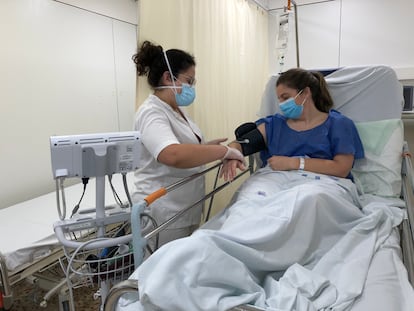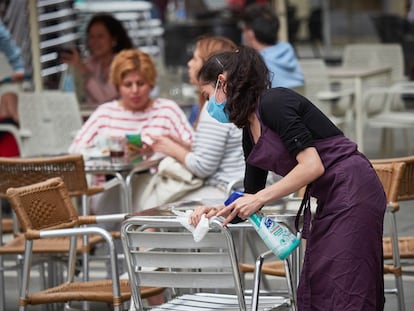Spain records lowest number of new coronavirus cases since March 5
According to the latest data, just 48 infections were registered in the country, a figure not seen since before the state of alarm was declared

The new coronavirus cases reported by the Spanish Health Ministry on Monday evening, and which correspond to the previous 24-hour period, fell to a new low since the state of alarm was declared by the government on March 14 in a bid to slow the spread of the epidemic. With 48 confirmed infections, not since March 5 has there been such a low number of cases. Shortly after that date, transmission of the virus became completely uncontrolled, and at the end of March there were as many as 10,000 infections detected in a single day.
Since the crisis began, however, the figures have tended to be misleading on Mondays, with underreporting over the weekend due to lower staffing levels in hospitals. According to the figures supplied last night by the ministry, no cases were detected in the previous 24 hours in the Balearic Islands, Castilla-La Mancha, Extremadura and Murcia. Nor were there any new diagnoses in the North African exclave cities of Ceuta and Melilla. In the last week, a total of 2,157 cases were detected, a figure that has been rising slightly over the last three days.
Hospitalizations in the last seven days came in at 145, which is also the lowest figure since the state of alarm was implemented
Fernando Simón, the director of the Health Ministry’s Coordination Center for Health Alerts, explained on Monday that nearly 40% of the cases registered in the last week were asymptomatic, and were detected in testing carried out in healthcare centers or residences. “This indicates that the progress [of the epidemic] continues to be favorable, as we have been observing over this last month or so,” he said.
The number of fatalities in the last week was 56 according to the latest ministry data, with no new deaths detected in the previous 24 hours. However, this “figure is frozen,” explained Simón, given that since the Health Ministry changed its statistical system two weeks ago, it has been revising the entire historical series, meaning that it is difficult to interpret the data. There are thousands of deaths that are yet to be assigned to a specific date, and that are in a kind of limbo. The ministry is due to include them in the updated data this week.
The figures may suffer a further change due to a new recommendation that was published recently by the World Health Organisation (WHO), which consists in not only including the number of fatalities where coronavirus was confirmed by a PCR test, as Spain has been doing up until now, but also including all suspected Covid-19 deaths that cannot be attributed to other causes. This, Simón admitted last night, could lead to a fresh reevaluation of the whole series.
One of the figures that offers a more immediate snapshot of the progress of the epidemic, provided that the regions notify cases quickly, is the number of cases diagnosed where symptoms began in the previous seven days. In the whole of Spain, this number is 0.53 per 100,000 inhabitants. No region exceeds two per 100,000, only the city of Ceuta – but this is due to its small population of 80,000 inhabitants, and two new registered cases.
The Balearic Islands, Castilla-La Mancha, Extremadura and Murcia detected no new cases in the past 24 hours
Admissions in intensive care units (ICUs) have held steady in recent days between 10 and 15 patients. On Monday, the figure came in at 14 for the previous 24 hours, in seven regions: Aragón, Cantabria, Castilla-La Mancha, Castilla y León, Catalonia, Madrid and Navarre.
Hospitalizations in the last seven days came in at 145, which is also the lowest figure since the state of alarm was implemented. All territories, apart from Melilla, saw at least one. This figure is particularly interesting for epidemiologists, given that it does not rely on capacity for detection. While it is a significant indicator, one that shows the epidemic is on a downward trend, the figures on Tuesday will confirm whether or not underreporting from the weekend has had an effect.
Simón also explained that while some healthcare workers have the impression that the virus is losing virulence, this may not necessarily be the case. The capacity for detection is ever greater, meaning that milder cases of coronavirus are being reported. “Before May 11 [when the new statistical system was put into action] the average age [of detected cases] was approximately 61 or 62,” he explained. “Since May 11, it’s 54, meaning that we are detecting younger cases, which are associated with being light.”
English version by Simon Hunter.
Tu suscripción se está usando en otro dispositivo
¿Quieres añadir otro usuario a tu suscripción?
Si continúas leyendo en este dispositivo, no se podrá leer en el otro.
FlechaTu suscripción se está usando en otro dispositivo y solo puedes acceder a EL PAÍS desde un dispositivo a la vez.
Si quieres compartir tu cuenta, cambia tu suscripción a la modalidad Premium, así podrás añadir otro usuario. Cada uno accederá con su propia cuenta de email, lo que os permitirá personalizar vuestra experiencia en EL PAÍS.
¿Tienes una suscripción de empresa? Accede aquí para contratar más cuentas.
En el caso de no saber quién está usando tu cuenta, te recomendamos cambiar tu contraseña aquí.
Si decides continuar compartiendo tu cuenta, este mensaje se mostrará en tu dispositivo y en el de la otra persona que está usando tu cuenta de forma indefinida, afectando a tu experiencia de lectura. Puedes consultar aquí los términos y condiciones de la suscripción digital.
More information
Últimas noticias
Most viewed
- Reinhard Genzel, Nobel laureate in physics: ‘One-minute videos will never give you the truth’
- Oona Chaplin: ‘I told James Cameron that I was living in a treehouse and starting a permaculture project with a friend’
- Pablo Escobar’s hippos: A serious environmental problem, 40 years on
- Why we lost the habit of sleeping in two segments and how that changed our sense of time
- The fall of a prolific science journal exposes the billion-dollar profits of scientific publishing











































